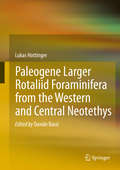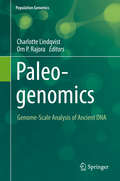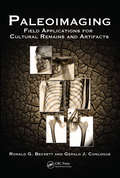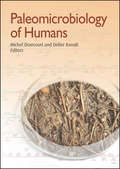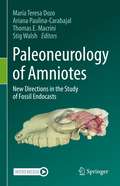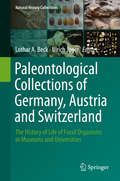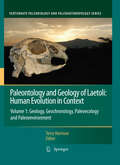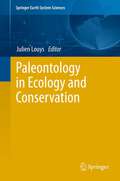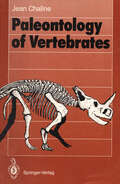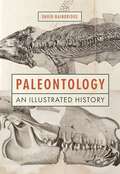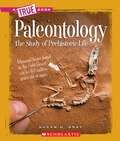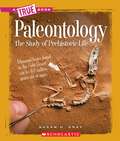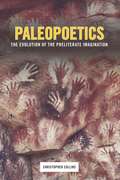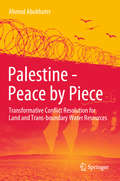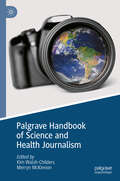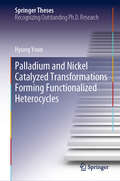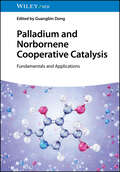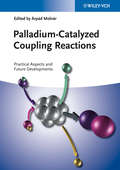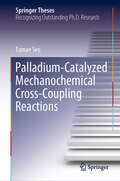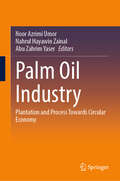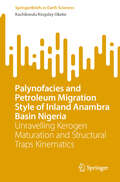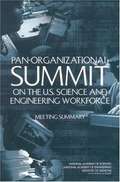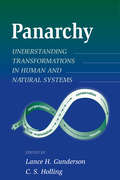- Table View
- List View
Paleogene larger rotaliid foraminifera from the western and central Neotethys
by Lukas Hottingerdavide BassiThis book provides a representative assessment of the state of the art of research on Paleogene rotaliid larger foraminifera. It gives an overview of the current understanding of systematics of this group and, in particular, of its biostratigraphic importance and palaeobiogeography. The senior author of the work, late Professor Hottinger, a leading scientist in the field, both from a systematic and applied side, presents in this book his most recent advances. The foraminiferal family Rotaliidae is a traditional group used frequently which plays an important role for petroleum exploration in the biostratigraphy and palaeobiogeography of Paleogene shallow water deposits in the Middle East. This book aims to introduce rotaliid representatives as index fossils that can be recognized in random thin-sections of cemented rocks. The book is generously illustrated with an unprecedented degree of accuracy. The selection of taxa is restricted to forms having lived in the Paleocene and the Eocene, where their biostratigraphic significance is much higher than during later epochs. However, some additional rotaliid taxa, from the Late Cretaceous or that do not belong to the family Rotaliidae sensu stricto, are included in this book in order to demonstrate particular roots of rotaliid phylogenetic lineages in the previous community maturation cycle or to delimit the taxon Rotaliidae with more precision. This book can be considered as a reference in the field.
Paleogenomics: Genome-Scale Analysis of Ancient DNA (Population Genomics)
by Charlotte Lindqvist Om P. RajoraAdvances in genome-scale DNA sequencing technologies have revolutionized genetic research on ancient organisms, extinct species, and past environments. When it is recoverable after hundreds or thousands of years of unintended preservation, “ancient DNA” (or aDNA) is often highly degraded, necessitating specialized handling and analytical approaches. Paleogenomics defines the field of reconstructing and analyzing the genomes of historic or long-dead organisms, most often through comparison with modern representatives of the same or similar species. The opportunity to isolate and study paleogenomes has radically transformed many fields, spanning biology, anthropology, agriculture, and medicine. Examples include understanding evolutionary relationships of extinct species known only from fossils, the domestication of plants and animals, and the evolution and geographical spread of certain pathogens. This pioneering book presents a snapshot view of the history, current status, and future prospects of paleogenomics, taking a broad viewpoint that covers a range of topics and organisms to provide an up-to-date status of the applications, challenges, and promise of the field. This book is intended for a variety of readerships, including upper-level undergraduate and graduate students, professionals and experts in the field, as well as anyone excited by the extraordinary insights that paleogenomics offers.
Paleoimaging: Field Applications for Cultural Remains and Artifacts
by Ronald G. Beckett Gerald J. ConlogueMedical and industrial imaging methods have come to be recognized as powerful tools for documentation and data collection in many nontraditional settings. In Paleoimaging: Field Applications for Cultural Remains and Artifacts, two of the most preeminent experts in the field provide an in-depth examination of a range of imaging techniques and explain how these techniques can be applied to all aspects of forensic and archaeological analysis.The first part of the book examines paleoimaging multimodalities, highlighting the advantages and disadvantages of each imaging technique in different scenarios. The authors explore photography, conventional radiography, endoscopy, and various forms of computer-based imaging. Next, they present methodological and procedural standards for the various imaging techniques. They also demonstrate how multimodal imaging can assist nondestructive data collection of non-biological cultural artefacts. A final section addresses radiation safety and field safety concerns. Case studies, tables, and templates of forms for documentation of findings enhance the text with practical information.Filled with over 380 images, this book is supplemented with an accompanying downloadable resource in which the authors draw from their global experience in the paleoimaging of cultural remains and artefacts, offering a view of the diverse environments in which field paleoimaging is conducted. The breadth of the authors’ expertise and the rich images contained in the book and downloadable resources make this resource an essential reference for those who seek to explore the mysteries of the past.
Paleomicrobiology of Humans (ASM Books)
by Michel Drancourt Didier A. RaoultOnly recently was it determined that two of the world's most devastating plagues, the plague of Justinian and the medieval Black Death, were caused by distinct strains of the same pathogen. Use of paleomicrobiological techniques led to this discovery. This work is just one example of the historical mysteries that this emerging field has helped to clarify. Others, such as when tuberculosis began to afflict humans, the role of lice in plague pandemics, and the history of smallpox, are explored and further illuminated in Paleomicrobiology of Humans. Led by editors Michel Drancourt and Didier Raoult, the book's expert contributors address larger issues using paleomicrobiology. These include the recognition of human remains associated with epidemic outbreaks, identification of the graves of disasters, and the discovery of demographic structures that reveal the presence of an epidemic moment. In addition, the book reviews the technical approaches and controversies associated with recovering and sequencing very old DNA and surveys modern human diseases that have ancient roots. Essentially, paleomicrobiologists aim to identify past epidemics at the crossroads of different specialties, including anthropology, medicine, molecular biology, and microbiology. Thus, this book is of great interest not only to microbiologists but to medical historians and anthropologists as well. Paleomicrobiology of Humans is the first comprehensive book to examine so many aspects of this new, multidisciplinary, scientific field.
Paleoneurology of Amniotes: New Directions in the Study of Fossil Endocasts
by María Teresa Dozo Ariana Paulina-Carabajal Thomas E. Macrini Stig WalshThis book presents a detailed examination of the current state of knowledge in the field of paleoneurology in the main amniote groups (reptiles, birds and mammals), and advances resulting from new non-invasive technologies. The study of fossil endocasts is an area of considerable current interest, and has long been central to our understanding of the evolution of the brain, development of senses and behavioral adaptations in diverse vertebrate groups and across vertebrates as a whole. Recent advances in non-invasive imaging have significantly increased the number of fossil taxa for which brain morphology is known, and it may now be possible to quantitatively analyze the relative size of brain regions. Providing a general overview of current perspectives and problems in evolutionary neuroanatomy, this book is intended for a wide range of readers, including undergraduate and graduate students, teachers, and anyone with a special interest in paleoneurology. It is also useful as supplementary reading for courses in digital anatomy, vertebrate comparative anatomy, computed morphometrics, paleontology, neurology and radiology as well as evolution programs
Paleontological Collections of Germany, Austria and Switzerland: The History of Life of Fossil Organisms at Museums and Universities (Natural History Collections)
by Lothar A. Beck Ulrich JogerThis book is devoted to 250 years of collecting, organizing and preserving paleontological specimens by generations of scientists. Paleontological collections are a huge resource for modern research and should be available for national and international scientists and institutions, as well as prospective public and private customers. These collections are an important part of the scientific enterprise, supporting research, public education, and the documentation of past biodiversity. Much of what we are beginning to understand about our world, we owe to the collection, preservation, and ongoing study of natural specimens. Properly preserved collections of fossil marine or terrestrial plants and animals are archives of Earth's history and vital to our ability to learn about our place in its future.The approach employed by the editors involves not only an introduction to the paleontological collections in general, but also information on the international and national collection networks. Particular attention is given to new exhibition concepts and approaches of sorting, preserving and researching in paleontological collections and also their neglect and/or threat. In addition, the book provides information on all big public museums, on important state museums and regional Museums, and also on university collections.This is a highly informative and carefully presented book, providing scientific insight for readers with an interest in fossil record, biodiversity, taxonomy, or evolution, as well as natural history collections at large.
Paleontology
by Derek TurnerIn the wake of the paleobiological revolution of the 1970s and 1980s, paleontologists continue to investigate far-reaching questions about how evolution works. Many of those questions have a philosophical dimension. How is macroevolution related to evolutionary changes within populations? Is evolutionary history contingent? How much can we know about the causes of evolutionary trends? How do paleontologists read the patterns in the fossil record to learn about the underlying evolutionary processes? Derek Turner explores these and other questions, introducing the reader to exciting recent work in the philosophy of paleontology and to theoretical issues including punctuated equilibria and species selection. He also critically examines some of the major accomplishments and arguments of paleontologists of the last 40 years.
Paleontology and Geology of Laetoli: Human Evolution in Context
by Terry HarrisonThis volume 2 and its companion volume 1 present the results of new investigations into the geology, paleontology and paleoecology of the early hominin site of Laetoli in northern Tanzania. The site is one of the most important paleontological and paleoanthropological sites in Africa, worldrenowned for the discovery of fossils of the early hominin Australopithecus afarensis, as well as remarkable trails of its footprints. The first volume provides new evidence on the geology, geochronology, ecology, ecomorphology and taphonomy of the site. The second volume describes newly discovered fossil hominins from Laetoli, belonging to Australopithecus afarensis and Paranthropus aethiopicus, and presents detailed information on the systematics and paleobiology of the diverse associated fauna. Together, these contributions provide one of the most comprehensive accounts of a fossil hominin site, and they offer important new insights into the early stages of human evolution and its context.
Paleontology in Ecology and Conservation
by Julien LouysThe fossil record contains unique long-term insights into how ecosystems form and function which cannot be determined simply by examining modern systems. It also provides a record of endangered species through time, which allow us to make conservation decisions based on thousands to millions of years of information. The aim of this book is to demonstrate how palaeontological data has been or could be incorporated into ecological or conservation scientific studies. This book will be written by palaeontologists for modern ecologists and conservation scientists. Manuscripts will fall into one (or a combination) of four broad categories: case studies, review articles, practical considerations and future directions. This book will serve as both a 'how to guide' and provide the current state of knowledge for this type of research. It will highlight the unique and critical insights that can be gained by the inclusion of palaeontological data into modern ecological or conservation studies.
Paleontology of Vertebrates
by Jean ChalinePaleontology of Vertebrates is an introductory text for students in Earth Sciences. It offers the basic knowledge and describes the evolution of vertebrate groups, successfully applying the cladistic approach. The reader will learn how vertebrate paleontology can contribute to solve problems in various fields of geosciences, such as biostratigraphy, paleoenvironmental reconstructions and geophysical modes.
Paleontology: An Illustrated History
by David BainbridgeAn illustrated look at the art and science of paleontology from its origins to todayHumans have been stumbling upon the petrified remains of ancient animals since prehistoric times, leading to tales of giant dogs, deadly dragons, tree gods, sea serpents, and all manner of strange and marvelous creatures. In this richly illustrated book, David Bainbridge recounts how legends like these gradually gave rise to the modern science of paleontology, and how this pioneering discipline has reshaped our view of the natural world.Bainbridge takes readers from ancient Greece to the eighteenth century, when paleontology began to coalesce into the scientific field we know today, and discusses how contemporary paleontologists use cutting-edge technologies to flesh out the discoveries of past and present. He brings to life the stories and people behind some of the greatest fossil finds of all time, and explains how paleontology has long straddled the spheres of science and art. Bainbridge also looks to the future of the discipline, discussing how the rapid recovery of DNA and other genetic material from the fossil record promises to revolutionize our understanding of the origins and evolution of ancient life.This panoramic book brings together stunning illustrations ranging from early sketches and engravings to eye-popping paleoart and high-tech computer reconstructions.
Paleontology: The Study of Prehistoric Life (A True Book (Relaunch))
by Susan H. GrayDiscover how paleontologists dig deep to discover these remains and how they use them to learn more about the plants and animals that once covered the planet.A True Book: Earth Science series presents fascinating facts and fun activities that will engage the budding earth scientist, while exploring the fields of geology, meteorology, ecology, and more. This series includes an age appropriate (grades 3-5) introduction to curriculum-relevant subjects and a robust resource section that encourages independent study.Millions of years ago, Earth was populated by animals unlike any that we know today. The only way to learn anything about these extinct species is to study the remains they have left behind in Earth's rocks and soil.
Paleontology: The Study of Prehistoric Life (True Books)
by Susan H. GrayWhether you're interested in weather, oceans, or even the prehistoric world, earth science covers it all. The fascinating facts and fun activities in these titles help the budding earth scientist in you explore the fields of geology, meteorology, ecology, and more.
Paleopoetics: The Evolution of the Preliterate Imagination
by Christopher CollinsChristopher Collins introduces an exciting new field of research traversing evolutionary biology, anthropology, archaeology, cognitive psychology, linguistics, neuroscience, and literary study. Paleopoetics maps the selective processes that originally shaped the human genus millions of years ago and prepared the human brain to play, imagine, empathize, and engage in fictive thought as mediated by language. A manifestation of the "cognitive turn" in the humanities, Paleopoetics calls for a broader, more integrated interpretation of the reading experience, one that restores our connection to the ancient methods of thought production still resonating within us.Speaking with authority on the scientific aspects of cognitive poetics, Collins proposes reading literature using cognitive skills that predate language and writing. These include the brain's capacity to perceive the visible world, store its images, and retrieve them later to form simulated mental events. Long before humans could share stories through speech, they perceived, remembered, and imagined their own inner narratives. Drawing on a wide range of evidence, Collins builds an evolutionary bridge between humans' development of sensorimotor skills and their achievement of linguistic cognition, bringing current scientific perspective to such issues as the structure of narrative, the distinction between metaphor and metonymy, the relation of rhetoric to poetics, the relevance of performance theory to reading, the difference between orality and writing, and the nature of play and imagination.
Palestine - Peace by Piece: Transformative Conflict Resolution for Land and Trans-boundary Water Resources
by Ahmed AbukhaterThis book draws lessons and conclusions, based on the methodology outlined in the author's previous book, Water as a Catalyst for Peace (Routledge, 2013), and further charts the course to a more practical framework for achieving regional stability and justice. Past agreements are examined and analysed, outlining the change along the way that occurred to the land and people of Palestine. The book is written with the intention of exposing past events that led to the current situation, evaluating the current state of the conflict in light of new circumstances and the reality on the ground. Viable options are explored to seek a practical and satisfactory negotiated settlement that ensures justice and viability. In conclusion, a roadmap for future direction is proposed to achieve equitable water allocation through proper negotiation between Israel and Palestine and to ultimately settle the conflict. Water resources allocation is at the heart of this pragmatic framework and roadmap.
Palgrave Handbook of Science and Health Journalism
by Kim Walsh-Childers Merryn McKinnonThis handbook reviews the extant literature on the most important issues in health and science journalism, with a focus on summarizing the relevant research and identifying key questions that are yet to be answered. It explores challenges and best practices in health and science reporting, formats and audiences, key topics such as climate change, pandemics and space science, and the ethics and political impacts of science and health journalist practice. With numerous international contributions, it provides a comprehensive overview of an emerging area of journalism studies and science communication.
Palladium Assisted Synthesis of Heterocycles
by Navjeet KaurThis book is a compilation of the recent applications of palladium catalysts in organic synthesis. The book demonstrates that it is a highly dynamic research field. This methodology has emerged as a powerful tool for the efficient and chemoselective synthesis of heterocyclic molecules. In the past few years, several strategies have been pointed out to pursue more efficient, sustainable, and environment friendly chemical processes. Among those strategies, catalysis and the design of new processes that avoid the use of toxic reagents have been the focus of intense research.
Palladium and Nickel Catalyzed Transformations Forming Functionalized Heterocycles (Springer Theses)
by Hyung YoonThis book presents Pd- and Ni-catalyzed transformations generating functionalized heterocycles. Transition metal catalysis is at the forefront of synthetic organic chemistry since it offers new and powerful methods to forge carbon–carbon bonds in high atom- and step-economy. In Chapter 1, the author describes a Pd- and Ni-catalyzed cycloisomerization of aryl iodides to alkyl iodides, known as carboiodination. In the context of the Pd-catalyzed variant, the chapter explores the production of enantioenriched carboxamides through diastereoselective Pd-catalyzed carboiodination. It then discusses Ni-catalyzed reactions to generate oxindoles and an enantioselective variant employing a dual ligand system. Chapter 2 introduces readers to a Pd-catalyzed diastereoselective anion-capture cascade. It also examines diastereoselective Pd-catalyzed aryl cyanation to synthesize alkyl nitriles, a method that generates high yields of borylated chromans as a single diastereomer, and highlights its synthetic utility. Lastly, Chapter 3 presents a Pd-catalyzed domino process harnessing carbopalladation, C–H activation and π-system insertion (benzynes and alkynes) to generate spirocycles. It also describes the mechanistic studies performed on these reactions.
Palladium and Norbornene Cooperative Catalysis: Fundamentals and Applications
by Guangbin DongA comprehensive exploration of Pd/Norbornene (NBE) catalysis In Palladium and Norbornene Cooperative Catalysis: Fundamentals and Applications, renowned researcher Professor Guangbin Dong delivers a systematic and comprehensive discussion of Pd/NBE catalysis, including its mechanisms, scopes, applications, and current limitations. The book provides readers with the fundamental knowledge they will need to use this type of catalysis in their own research, as well as how to choose the best reaction conditions and catalyst combinations. Each of the eight chapters are written by leading experts in the Pd/NBE catalysis field. They cover topics ranging from the mechanistic foundation of Pd/NBE catalysis to the scope of the ipso and ortho functionalization, asymmetric development, a review of the Pd/NBE-catalyzed heteroarene functionalization, and more. Readers will also find: A thorough introduction to intramolecular and intermolecular cyclizationsComprehensive explorations of the annulation chemistryPractical discussions of Pd(II)-initiated reactionsA complete summary of a variety of applications in the synthesis of complex molecules and organic materials using Pd/NBE catalysis Perfect for chemistry students with an interest in transition-metal catalysis and organic synthesis. This book will also benefit academic researchers and practicing chemists.
Palladium-Catalyzed Coupling Reactions
by Árpád MolnárThis handbook and ready reference brings together all significant issues of practical importance in selected topics discussing recent significant achievements for interested readers in one single volume. While covering homogeneous and heterogeneous catalysis, the text is unique in focusing on such important aspects as using different reaction media, microwave techniques or catalyst recycling. It also provides a comprehensive treatment of key issues of modern-day coupling reactions having emerged and matured in recent years and emphasizes those topics that show potential for future development, such as continuous flow systems, water as a reaction medium, and catalyst immobilization, among others.With its inclusion of large-scale applications in the pharmaceutical industry, this will equally be of great interest to industrial chemists.From the contents* Palladium-Catalyzed Cross-Coupling Reactions - A General Introduction* High-turnover Heterogeneous Palladium Catalysts in Coupling Reactions: the Case of Pd Loaded on Dealuminated Y Zeolites Palladium-Catalyzed Coupling Reactions with Magnetically Separable Nanocatalysts* The Use of Ordered Porous Solids as Support Materials in Palladium-Catalyzed Cross-Coupling Reactions* Coupling Reactions Induced by Polymer-Supported Catalysts* Coupling Reactions in Ionic Liquids* Cross-Coupling Reactions in Aqueous Media* Microwave-Assisted Synthesis in C-C and C-Heteroatom Coupling Reactions* Catalyst Recycling in Palladium-Catalyzed Carbon-Carbon Coupling Reactions* Nature of the True Catalytic Species in Carbon-Carbon Coupling Reactions with* Heterogeneous Palladium Precatalysts* Coupling Reactions in Continuous Flow Systems* Large-Scale Applications of Palladium-Catalyzed Couplings in the Pharmaceutical Industry
Palladium-Catalyzed Mechanochemical Cross-Coupling Reactions (Springer Theses)
by Tamae SeoIn this thesis, the author developed cross-coupling reactions that proceed in the solid state without using organic solvents, utilizing a mechanochemical synthesis method using a ball mill. Compared to conventional solution systems, the reactions realized a drastic reduction of chemical waste, a drastic acceleration of chemical reactions, and efficient transformations of insoluble compounds. The thesis demonstrates that mechanochemical synthesis method has the potential to revolutionize organic synthesis. Readers can learn not only about mechanochemical synthesis but also about new reactions and syntheses of new compounds that could not be obtained under solution conditions. Recently, mechanochemical synthesis has become increasingly popular among a wide range of researchers as an environmentally friendly and highly efficient method, so this thesis has a timely publication.
Palm Oil Industry: Plantation and Process Towards Circular Economy
by Abu Zahrim Yaser Noor Azrimi Umor Nahrul Hayawin ZainalThis book highlights current efforts and research on sustainable solutions for the palm oil industry, including production and waste management. It provides an overview of sustainable principles and practices within the industry and explores ongoing initiatives to utilize various oil palm waste. In addition to extraction of lignin and cellulose, the book also discusses the use of oil palm biomass for environmental remediation.
Palynofacies and Petroleum Migration Style of Inland Anambra Basin Nigeria: Unravelling Kerogen Maturation and Structural Traps Kinematics (SpringerBriefs in Earth Sciences)
by Kachikwulu Kingsley OkekeThis book highlights a detailed high-resolution palynofacies origin and depositional environment, source rock potential, hydrocarbon migration pathway and structural hydrocarbon entrapment mechanisms of the outcrop lithostratigraphic units of the inland Anambra basin. It broadens readers’ geoscientific conceptualization in the appraisal of the quantity and quality of outcrop scale, generated chemical macerated palynofacies elements and kerogen maturation synthesis, palynofacies hydrodynamics and sedimentary structures trapping orientation and configurations, structural mechanics and lateral facies changes. This boils down to perfect comprehension of the sedimentary, palaeontological data and natural plant evolution, growth and depositional processes in order to authenticate their origin and provenance, depositional environment and hydrocarbon production potential within the context of the basin. Presence of texturally mature coarse- to fine-grained sandstones, variable sedimentary structures, internal bed geometries and nature of bedding, age and palynofacies hydrodynamics are vital prognostic stratigraphic and paleoenvironment indices culminated in the kerogen types, organic thermal maturation, seals and reservoir rock quality along with kinematics-driven faults and joints in time and space. These geoscientific concepts were summarily authenticated in the specific objectives and chapter series of this book along with modelled prognosis for potential conventional and unconventional hydrocarbon prospects to contribute more information to oil exploration campaign in the inland basin.
Pan-organizational Summit On The U.s. Science And Engineering Workforce: Meeting Summary
by Marye Anne FoxEach of 32 nonprofit organizations contributing a presentation to the Pan-Organizational Summit on the Science and Engineering Workforce (November 11-12, 2002; The National Academies, Washington, DC) was invited to issue a corresponding position paper to be reproduced in this volume. The bulk of this report comprises these papers. In addition, Shirley Jackson and Joseph Toole, two of the keynote speakers, have included their remarks.
Panarchy: Understanding Transformations in Human and Natural Systems
by C. S. Holling Lance H. GundersonCreating institutions to meet the challenge of sustainability is arguably the most important task confronting society; it is also dauntingly complex. Ecological, economic, and social elements all play a role, but despite ongoing efforts, researchers have yet to succeed in integrating the various disciplines in a way that gives adequate representation to the insights of each.Panarchy, a term devised to describe evolving hierarchical systems with multiple interrelated elements, offers an important new framework for understanding and resolving this dilemma. Panarchy is the structure in which systems, including those of nature (e.g., forests) and of humans (e.g., capitalism), as well as combined human-natural systems (e.g., institutions that govern natural resource use), are interlinked in continual adaptive cycles of growth, accumulation, restructuring, and renewal. By understanding these cycles and their scales, researchers can identify the points at which a system is capable of accepting positive change, and can use those points to foster resilience within the system.This volume brings together leading thinkers on the subject to develop and examine the concept of panarchy and to consider how it can be applied to human, natural, and human-natural systems. Throughout, contributors seek to identify adaptive approaches to management that recognize uncertainty and encourage innovation while fostering resilience.The book is a fundamental new development in a widely acclaimed line of inquiry. It represents the first step in integrating disciplinary knowledge for the adaptive management of human-natural systems across widely divergent scales, and offers an important base of knowledge from which institutions for adaptive management can be developed. It will be an invaluable source of ideas and understanding for students, researchers, and professionals involved with ecology, conservation biology, ecological economics, environmental policy, or related fields.
